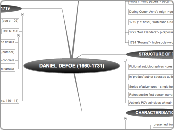DANIEL DEFOE (1660-1731)
THE MAN & THE WRITER
Family of "Dissenters" = refuse authority of Church of England
Received good education
Wrote in Whig papers = became famous intellectual (political essays & pamphlets)
During Queen Anne's reign > got arrested > denied his Whig ideas
1719 (1st novel) "Robinson Crusoe"
1722 "Moll Flanders" - pickpocket repents and becomes rich
1724 "Roxana" - high-society woman obtains what she wants thanks to her beauty
STRUCTURE OF THE NOVELS
Fictional autobiographies - presented as 'true' stories
In 'preface' author stresses authenticity
Series of adventures - single hero
Retrospective first-person narration
Author's POV coincides w/ main character
CHARACTERISATION
Characters
presented from their inside & by their actions
appear 'isolated' (physically or socially) & in a struggle for survival or daily bread
& in a struggle for survival or daily bread
Father of Engl. Novel
Narrative technique = original
Basis for development of realistic novel
Gave voice to a new social class
"Robinson Crusoe" 1719
PLOT (see p. 109)
THE STYLE
Objective approac to events > precise details
Description of primary qualities of objects (solidity, extension, number)
Language = simple & concrete
1st person narrator
"It was in vain to sit still" (see p. 110-111)
Present narrative technique and POV
Notice chronological order
Discuss Robinson's approach to the problems he must solve
How does he overcome the moment of sadness in the passage?
Symbolism: the 'ship' + the ''sea'
Robinson's view of 'nature'
Robinson's approach to his new situation reflects ideology of 18th century
